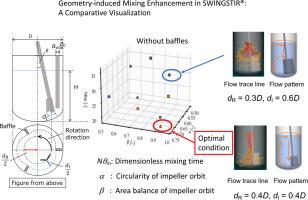配备旋涡型叶轮(SWINGSTIR®)的搅拌槽内的流动和混合特性
IF 6.3
3区 工程技术
Q1 ENGINEERING, CHEMICAL
Journal of the Taiwan Institute of Chemical Engineers
Pub Date : 2025-08-04
DOI:10.1016/j.jtice.2025.106309
引用次数: 0
摘要
搅拌容器内的混合性能受到叶轮几何形状的强烈影响。特别是,旋涡型叶轮,如SWINGSTIR®表现出独特的流动行为,由于他们的非旋转,振荡运动。然而,叶轮叶片宽度(dI)和旋转直径(dR)对混合和流动特性的影响尚未得到充分的了解。方法通过脱色实验、超声测速仪(UVP)测量和移动粒子半隐式(MPS)计算流体动力学(CFD)模拟,研究dI和dR对混合性能的影响。试验了一系列不同几何形状的结构,以确定最佳混合条件。重要发现:随着叶片宽度dI的增加,搅拌性能下降,这可能是由于容器底部附近的再循环流动增强,抑制了轴向混合。相反,增加dR可以改善湍流强度,提高混合效率。dI和dR对叶轮的轨迹都起着至关重要的作用:较大的dI会导致轨道畸变,而较大的dR会在靠近容器中心的地方产生空腔。利用轨道圆度和面积平衡参数进行定量评价表明,当叶轮轨道接近圆形且流区空间分布平衡时,混合效果最好。这些结果突出了几何相互作用在叶轮设计中的重要性,并为优化旋流型系统的混合性能提供了指导。本文章由计算机程序翻译,如有差异,请以英文原文为准。

Flow and mixing characteristics in a stirred tank equipped with a swirl-type impeller (SWINGSTIR®)
Background
The performance of mixing in stirred vessels is strongly influenced by impeller geometry. In particular, swirl-type impellers such as SWINGSTIR® exhibit unique flow behavior due to their non-rotational, oscillatory motion. However, the effects of impeller blade width (dI) and rotation diameter (dR) on mixing and flow characteristics remain insufficiently understood.
Method
This study investigates the influence of dI and dR on mixing performance through a combination of decolorization experiments, ultrasonic velocity profiler (UVP) measurements, and computational fluid dynamics (CFD) simulations using the moving particle semi-implicit (MPS) method. A series of configurations with varying geometries were tested to identify optimal mixing conditions.
Significant findings
Mixing performance decreased with increasing blade width dI, likely due to enhanced recirculating flow near the vessel bottom that inhibited axial mixing. Conversely, increasing dR improved turbulence intensity and enhanced mixing efficiency. The trajectory of the impeller tip—shaped by both dI and dR—played a critical role: larger dI caused orbit distortion, while larger dR created a cavity near the vessel center. Quantitative evaluation using orbit circularity and area balance parameters showed that mixing was most effective when the impeller orbit was nearly circular and the spatial distribution of flow regions was balanced. These results highlight the importance of geometric interaction in impeller design and provide guidance for optimizing mixing performance in swirl-type systems.
求助全文
通过发布文献求助,成功后即可免费获取论文全文。
去求助
来源期刊
CiteScore
9.10
自引率
14.00%
发文量
362
审稿时长
35 days
期刊介绍:
Journal of the Taiwan Institute of Chemical Engineers (formerly known as Journal of the Chinese Institute of Chemical Engineers) publishes original works, from fundamental principles to practical applications, in the broad field of chemical engineering with special focus on three aspects: Chemical and Biomolecular Science and Technology, Energy and Environmental Science and Technology, and Materials Science and Technology. Authors should choose for their manuscript an appropriate aspect section and a few related classifications when submitting to the journal online.

 求助内容:
求助内容: 应助结果提醒方式:
应助结果提醒方式:


